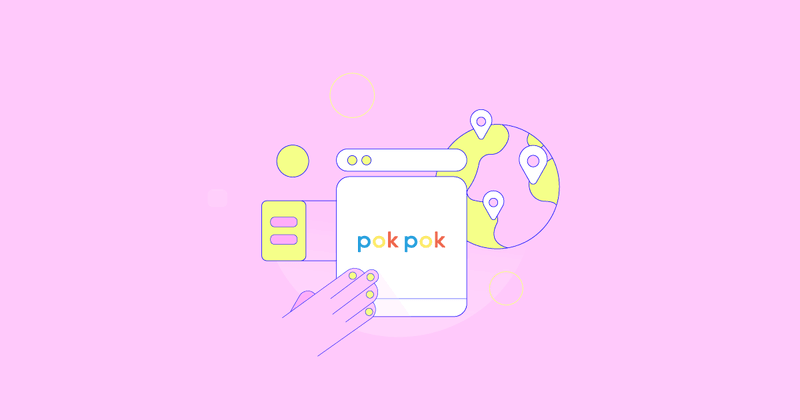Why localization has been so important for kids app, Pok Pok
Localization has been critical to Pok Pok's global growth. Find out why from co-founder and CEO, Melissa Cash.

Kids app Pok Pok receives over 30,000 downloads every month on iOS. And while the US is their biggest market, about two-thirds of their downloads come from the rest of the world. Of those, about 15% are from China, their second biggest market.
For Pok Pok, localization has been critical in their success beyond English-speaking markets. And this wasn’t a decision they came to down the road: they knew they wanted to localize for all key regions right from the beginning. Partly, this comes down to the type of content the app offers.
“Since Pok Pok provides a language-free experience for kids (just play, no rules, menus, etc.), we knew we wanted it to be available globally from day one.”
Melissa Cash, Pok Pok
I spoke to co-founder and CEO, Melissa Cash, to find out more about the why and how of localization for Pok Pok.
Find out why localization is 2023’s big growth opportunity >>

Why localize in the first place?
Pok Pok being a language-free experience for kids made the decision to be available around the world an obvious one. Look to where your potential user base is. Are those regions, for your category, dominated by apps in the native language? If so, there’s little chance of competing without localizing.
But for a kids app specifically, there are some unique considerations. The first, and perhaps most important, is building parent trust. While the primary users of a kids app are children, it’s the parents who are responsible for what apps are available to their kids (and what’s being paid for). Therefore, it’s essential that parents trust the app — if they don’t, they won’t bother downloading. And one of the ways you build trust with parents is through understanding. Parents need to know what their kids are getting with an app.
“This is particularly important for us in key countries with large populations (i.e. China, Germany, etc) as they are used to seeing media localized and when it’s not, it can be off-putting.”
This isn’t just a consideration for kids apps, either. All apps need to consider user experience and messaging. What will give users the path of least resistance? How can you communicate your proposition as quickly and simply as possible?
“Even if you’re not a kid’s app, it’s important to consider what is comfortable for people. Make it as easy as possible for them to understand your value prop and why they should download your app.”
We wrote more about parent trust in our blog: What’s the best way to monetize kids apps?
And finally, localizing fully into a country gives you the chance of being featured in local App Store storefronts. Building relationships with the local App Store teams is easier when you show them that you’re invested in their market.

How to decide on which countries to fully localize into
“Pok Pok is available in every country that the App Store is but it’s not economical for us to localize into every single language.
When making decisions about localization, we started with the top 20 regions where we felt we’d have the biggest impact and then edited the list down from there. If we felt that the app would be a good fit for the market (considering social and economic factors) or saw growth potential in a certain market, we would definitely localize.
We also considered the importance of having various versions of the same language, i.e. Spanish (Mexico vs Spain vs South American countries) or Portuguese (Portugal vs Brazil). Parents who are in the Grown-Ups section of the app or who find us on the App Store can interact and read in the language they’re most comfortable with.
Finally, consider which languages give you the most bang for your buck. Consider French. It’s a language spoken all over the world in different dialects and you need to ask yourself if it’s worth localizing all of them, or only one or two. Spanish, French, Portuguese, etc. are all good examples.”
On the “how” of localization (and finding the right partner)
Because localization was an early decision, Pok Pok’s developers built the app’s infrastructure to be able to do it smoothly. From there, it’s about finding the right partner.
“Find a localization partner you can trust. This is a very hard thing to gut check or cross reference without native speakers, so it’s worth more due diligence up front for the investment in a long-term relationship.
We have worked with a handful of different service providers for localization and always look for ones that can provide contextual localization, meaning that they’re willing to take the time to understand your product and the context before simply “translating” word for word. Translation is different from localization, as there are often cultural nuances and colloquialisms that it’s wise to be mindful of when it comes to localization.”
Final tips for apps looking to localize for the first time:
- “Consider all of the design implications of localization. Some languages require more or less space in your UI. This can really change the way your app comes across or look very unpolished if it’s not done well.”
- Remember that when you have users in a particular country, especially when you’ve localized for it, they will contact support in their own language. Try, whenever you can, to respond in their own language. If you take your customer service seriously, “it’s worth the investment to try to accommodate.” That might mean finding multilingual colleagues or friends to help, or even using translation tools.
- “Think about your user. Do they care if the app is in their native language? Does it matter if you use British English in the US? It might matter a lot if you’re a language learning or reading app, whereas for a video game might not be as critical.”
- If you’re localizing for China, it’s critical to localize both Traditional and Simplified Chinese.
Gain even more insights from Melissa in our podcast episode with her and Pok Pok Head of Growth, Félix Boudreau.
You might also like
- Blog post
The creative testing system that slashed our CAC (and scaled our spend)
We scaled Meta ad spend by 74.6% and dropped CAC 40%. Here’s how.
- Blog post
Building a lovable alien and a $1M ARR AI app
Ajay Mehta explains how smart monetization and standout characters helped Tolan cut through the AI hype.
- Blog post
Why Your Apple Search Ads Attribution Is About to Spike—And What It Actually Means
How view-through attribution impacts your acquisition analytics

